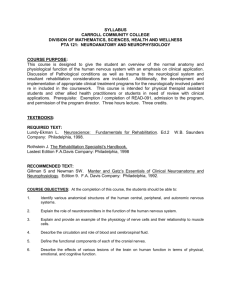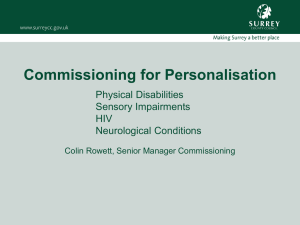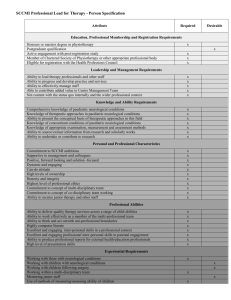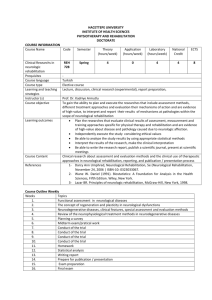LONG TERM CONDITIONS : BRIEFING – QUESTIONS FOR
advertisement
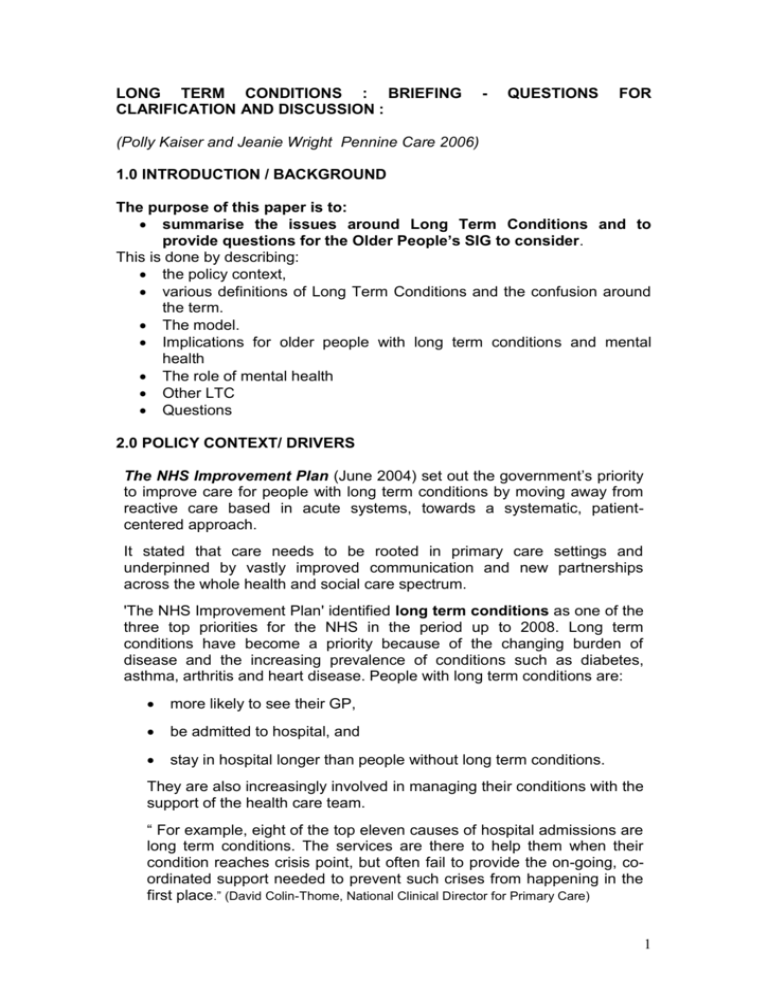
LONG TERM CONDITIONS : BRIEFING CLARIFICATION AND DISCUSSION : - QUESTIONS FOR (Polly Kaiser and Jeanie Wright Pennine Care 2006) 1.0 INTRODUCTION / BACKGROUND The purpose of this paper is to: summarise the issues around Long Term Conditions and to provide questions for the Older People’s SIG to consider. This is done by describing: the policy context, various definitions of Long Term Conditions and the confusion around the term. The model. Implications for older people with long term conditions and mental health The role of mental health Other LTC Questions 2.0 POLICY CONTEXT/ DRIVERS The NHS Improvement Plan (June 2004) set out the government’s priority to improve care for people with long term conditions by moving away from reactive care based in acute systems, towards a systematic, patientcentered approach. It stated that care needs to be rooted in primary care settings and underpinned by vastly improved communication and new partnerships across the whole health and social care spectrum. 'The NHS Improvement Plan' identified long term conditions as one of the three top priorities for the NHS in the period up to 2008. Long term conditions have become a priority because of the changing burden of disease and the increasing prevalence of conditions such as diabetes, asthma, arthritis and heart disease. People with long term conditions are: more likely to see their GP, be admitted to hospital, and stay in hospital longer than people without long term conditions. They are also increasingly involved in managing their conditions with the support of the health care team. “ For example, eight of the top eleven causes of hospital admissions are long term conditions. The services are there to help them when their condition reaches crisis point, but often fail to provide the on-going, coordinated support needed to prevent such crises from happening in the first place.” (David Colin-Thome, National Clinical Director for Primary Care) 1 There is a clear expectation that service re-design in this area will result in improved delivery of services to patients, resulting in general improvements in the health of the population, but there is also a specific target placed on the NHS to reduce inpatient bed-days by 5% by March 2008. This White Paper “Our Health, Our Care, Our Say” (January 2006) sets a new direction for the whole health and social care system. It covers and emphasises the following areas: Mental Health and well-being Easier access Brining care to community Better information Improved health Care for people with ongoing needs Help for carers Joined up care It confirms the vision set out in the Department of Health Green Paper, “Independence, Well-being and Choice”. Basically the paper is saying that we need to look at prevention, providing more care in the community in peoples homes and that there is a clear the requirement for joined up commissioning. The Commission for Social Care’s recent inspection backs up this with condemnation of the homecare services in England saying we need to relook at how we provide these services, and have a needs led service not a resource led service for individuals. Although we continue to have an ageing population. (there will soon be more over 60’s than under 5’s ) the actual Long Term (Neurological) Conditions National Service Framework (LTnC NSF March 2005) explicitly only covers adults of working age – even though many people over 65 have neurological conditions. The NSF aims to transform the way health and social care services support people to live with long-term neurological conditions. Key themes are independent living, care planned around the needs and choices of the individual, easier, timely access to services and joint working across all agencies and disciplines involved. The principles of the NSF are also relevant to service development for other long-term conditions. (my italics) It can be seen from the language in the policy documents that there is some confusion as to the terminology. However, they seem to be defining neurological conditions as one of a number of long term conditions which would benefit from this approach. 2 3.0 DEFINTIONS : The term ‘Long Term Conditions’ seems to have recently replaced that of ’Chronic Disease’ in most publications. This is a source of considerable confusion, however, as it combines and confuses the remit of the social care “supporting people with long term conditions” paper which came out in January 2006 with the Long Term (neurological) conditions NSF which was published in March 2006. The former would definitely be seen as covering health needs related to older people while the later does not. For example the former covers : Diabetes Chronic obstructive pulmonary disease (COPD) Heart Failure Asthma. These are included in the scope of most strategies across the country. Some LTC strategies also include: Depression, Dementia, Stroke Other neurological conditions such as Parkinson’s Disease, MS and epilepsy Arthritis However - This is not what the LTnC NSF covers and while neurological conditions affect people of all ages the LTC NSF explicitly concentrates on services for adults of working age (Everybody’s Business not permeated that group !) Thus, the definition is not at all clear in policy documents, commissioning discussions and local interpretations. It is not clear from the Greater Manchester documentation what the definition of the scope is. The implication seems to be that Stroke, Depression and Dementia are already covered by the Older People’s NSF The DOH has provides the following cheery definition : “Chronic diseases are diseases which current medical interventions can only control not cure. The life of the person with a chronic condition is forever altered. There is no return to normal “ 3 4.0 THE LONG TERM CONDITIONS MODEL Over fifteen million people in this country report living with a long term condition. Long-term conditions are those conditions that cannot, at present, be cured, but can be controlled by medication and other therapies. They include diabetes, asthma, and chronic obstructive pulmonary disease. Of these, many live with a condition that limits their ability to cope with dayto-day activities. For some people, especially older people and those who have more than one condition, discomfort and stress is an everyday reality. For those living in disadvantaged circumstances or for whom English is not their first language, the challenges are even greater. And for the most vulnerable, a lack of co-ordinated, personalised care can lead to a significant deterioration in health and often avoidable emergency admissions. The recommended route to deliver a systematic approach is to utilise multiprofessional teams and integrated patient pathways to ensure closer integration between health and social care. All health and social care services should begin to adopt this approach. Different interventions should then be used for patients with different degrees of need. The NHS and Social Care Long Term Conditions Model sets out a delivery system that matches care with need. NHS and social care organisations will be familiar with the Kaiser Permanente triangle. 4.1 The Model builds on this approach. Level 1: Self-management /supported self care Most people with a long-term condition are usually able to manage their own condition, if they have the right advice and support. The expert patient programme (EPP) is helping individuals and their carers to develop the knowledge, skills and confidence to care for themselves and their condition effectively. applications to MH ? links with health promotion etc (See Peter Elton presentation for detailed examples but : 4 eg’s = respondents who rated that they were in severe pain 40% had a GHQ 12 >4 (i.e. psychiatric caseness) Respondents with a visual impairment 40% GHQ12 >4 25% people in Bury Health Survey with COPD also depressed) Depression groups Hearing voices network DASNI – for people with a dementia Disease management This involves providing people who have a complex single need or multiple conditions with responsive, specialist services using multidisciplinary teams and disease specific protocols and pathways. Other patients need more support in caring for themselves, with particular emphasis on avoiding complications and slowing down their disease. With proper support in primary care and other programmes that meet individual need, severe phases of illness can be delayed or avoided. e.g’s from OPMH Case management A smaller group of patients with particularly wide-ranging problems need a highly personalised service. Evidence shows that high quality and personalised case management can improve patients’ lives dramatically, reducing non-planned admissions to hospital and allow patients to return home more quickly. The key to meeting the personal needs of these patients will be a new type of specialist clinician, often a nurse, who works with patients and social care providers to manage the delivery of care. Many patients requiring this type of care will be elderly, with a number of ‘chronic’ (long-lasting) conditions, often on several different medications, who are at high risk of emergency admission to hospital. Care for these patients is to be managed using a community matron or other professional using a case management approach, to anticipate, co-ordinate and join up health and social care. 4.2 LTnC NSF - 11 Quality Requirements The LTnC NSF has 11 key quality indicators : 1: A person-centered service This is a main theme that runs throughout the NSF. All people with longterm neurological conditions are offered a full assessment of their health and social care needs. In addition, they are to be offered information and education about their condition; the chance to make decisions about their treatment; and to be involved in writing a plan about how their needs will be met (a care plan). 5 2: Early recognition followed by prompt diagnosis and treatment Anyone suspected of having a long-term neurological condition is to quickly see a doctor or other professional, with expert knowledge of that condition. They should have tests, be given a diagnosis and have any treatment they need. This should be as close to home as possible. This is so that a correct diagnosis and appropriate treatment happens as soon as possible. 3: Emergency and acute management Anyone admitted to hospital for a neurosurgical or neurological emergency is assessed and treated by professionals with the right skills and experience who have access to the right facilities and equipment. 4: Early and specialist rehabilitation Anyone with a long-term neurological condition who would benefit from rehabilitation is to receive timely, high quality rehabilitation services in hospital or other specialist settings when they need them. When ready, they are to receive the support they need to return home for more community rehabilitation and support. 5: Community rehabilitation and support People with long-term neurological conditions living at home are to receive a full range of rehabilitation, advice and support to meet their continuing and changing needs. This is to increase their independence and help them to live as they wish. 6: Vocational rehabilitation People with long-term neurological conditions are to have appropriate support to help them find or regain employment, to remain in work or to pursue educational opportunities. 7: Equipment and accommodation People with long-term neurological conditions are to have the equipment they need (such as wheelchairs), within an appropriate time frame and to have adaptations made to their homes as and when needed, to support them to live independently; help them with their care; maintain their health; and improve their quality of life. 8: Personal care and support Health and social care services are to work together to ensure that people with long-term neurological conditions are given the care and support they need to live independently in their own homes wherever possible. 9: Palliative care People with long-term neurological conditions nearing the end of their life are to have access to a range of palliative care services as and when they need them, to control symptoms and offer pain relief, and to meet any personal needs they may have. 6 10: Support for family and carers All carers of people with long-term neurological conditions are to receive appropriate support and services which recognise their needs as a carer and as an individual in their own right. 11: Care during admission to hospital or other health and social care settings All people with long-term neurological conditions are to have their specific neurological needs met when they are receiving care for any other reason in any health or social care setting. These are similar to principles in the Mental Health NSF and Older Peoples NSF. Changing health care needs closely related to the aging population will require the provision of more long-term care for the treatment of chronic conditions. The implications of this are: Priority to develop long term care services and facilities and social care Focus the health economy on the provision of long term care and remodel the service required from acute care providers appropriately Promote the philosophy of in reach to secondary care where appropriate, with older people being maintained, cared for and treated in the community 5.0 OLDER PEOPLE , MENTAL HEALTH AND LONG TERM CONDITIONS The main users of health services are people aged 65+ (‘older people’). Over 80% of people aged 70+ suffer from a significant (i.e. in need of treatment) physical illness (Rossman, 1979). At any one time in the UK older people occupy around two-thirds of hospital beds (Department of Health, 2001). There is a vast amount of evidence and research highlighting the high national and local prevalence of unrecognised, and subsequently unmet, mental health needs of older people with acute physical illness admitted to general hospital wards: Older patients prescribed neuroleptic medicines (drugs used to treat mental disorders but also to subdue patients) are particularly prone to side-effects, such as a greater risk of falls and hip fractures (Fraser, 2003). Increased health care utilisation and costs (Waxman et al, 1983). People with long-term conditions frequently have more than one condition. Around half of this population will have more than one major health problem and around a quarter will have three or more problems (British Household Panel Survey 2001), with the chances of having more than one problem increasing with age. As people grow older, their health needs become more complex with physical and mental health needs frequently being inter-related and impacting on each other. Examples include: 7 Both physical and mental health difficulties can affect an individual’s ability to care for themselves independently and potentially have major implications for their way of life. For example, surveys indicate that 25% of people receiving home care services are depressed. Physical health difficulties can both contribute to and be compounded by depression and anxiety, as well as acute and chronic confusion. Conditions associated with chronic pain, and those leading to the loss of independence, and possibly the loss of the family home if a move is necessary, are commonly associated with depression. A persons ability to look after their own health, by taking a good diet, keeping active both mentally and physically, managing medication correctly and co-operating with treatment, can be adversely affected by depression or confusional states, such as dementia. Many older people receive multiple types of medication. Any medication has the potential to cause adverse effects as well as benefits. Any new or changed treatment to help a physical condition can lead to, or worsen, mental health problems. Similarly, treatment for mental health problems can adversely affect physical health in vulnerable older people. People with diagnosable physical illnesses, especially chronic or recurrent conditions commonly show higher rates of mental health problems than the general population. Recovery from or the management of, for example diabetes and coronary heart disease can be compromised as a consequence of mental health problems, especially depression. (DOH 2003). Rates of depression in severe and chronic diseases can be high. It has been shown that up to 60 % of people who have suffered a stroke can be depressed, up to 40 % of people with coronary heart disease, cancer, Parkinson’s Disease and Alzheimer’s can also be suffering from a depression. 5.1 The consequences of depression can be fatal: In one study, older patients with depression following a myocardial infarction were much more likely to die in the first 4 months after the event (Romanelli et al, 2002). Depression in late life was an independent risk factor for heart failure among elderly women in another study (Williams et al., 2002). Review evidence suggests that depression increases mortality and morbidity in ischaemic heart disease (Roose, Glassman and Seidman (2001). The latest evidence of suicide rates from the NW observatory seem to be suggesting an increase in suicide rates of people over 65. 5.2 There is evidence of a higher than average incidence of long-term conditions in the over 50 age group within BME community. This also needs to be considered 8 5.3 Continuing Care Monies The mental health component for nursing care is free. This has huge implications. There have been changes in the way assessments are made in the nursing determination which means that there are now only two funding bands . The criteria are very specific. There are possible implications for people with a dementia that will need to be monitored. There are also concerns around delays for approval, there are anxieties for patients and carers alike and increased costs to mental health and other organisations, Joined up commissioning and the new continuing care guidance and assessment tool may improve the process, however there is much to be done to educate potential lead key workers, on both the roles and responsibilities of the task and the wording to use. 6.0 WHAT IS THE ROLE OF MENTAL HEALTH ? This section describes how mental health practioners can be used in the broader health services with physically ill clients, and those with co-morbid psychological problems. Mental health is not merely the domain of Standard 7 (mental health) of the Older People’s NSF but is relevant in all aspects of the NSFOP. Mental well-being affects progress and recovery in every setting. More specifically, drawing on health psychology, evidence exists of the effectiveness of psychological intervention contributing to physical care in a range of fields including the following: cancer, chronic pain, coronary heart disease, irritable bowel syndrome, Parkinson’s’ disease, arthritis, terminal care, stroke and chronic obstructive air diseases. Mental health practioners can contribute to assessments around a number of issues. Personality factors, health and illness behaviour, attributions and health beliefs, for example can all affect treatment adherence. Co-morbid psychiatric disorders such as depression and dementia can affect treatment compliance, morbidity and mortality in physically ill older people (Ariyo et al, 2000, Rapp et al 1988, Cole 1983, Koenig et al 1989, Cooper 1987, Evans et al, 1997). Interventions might include : * Helping the person adjust to their illness * Education and training around coping strategies * Help with pain management * Incorporation of neuropsychological information in rehab and treatment plans * Multidisciplinary working around breaking bad news, skills training, joint care planning. * Support for carers * Management of behavioural problems * Bereavement * Burn out and stress in staff 9 Service research and development This evidence speaks of the need for an increasingly psychologically minded workforce. OTHER LONG TERM CONDITIONS : Stroke Over 100,000 people each year in England and Wales have a first stroke. While 10,000 are under retirement age the majority of people are 65 plus. Indeed half are 75 and above (Stoke Association). It has been estimated that each un-rehabilitated stroke patient costs society £64,000 more over the course of a lifetime compared to a rehabilitated one. Given that mood disorders are associated with worse outcomes in the longer term including increased morbidity and mortality (House, Knapp et al 2001; Pohjarvaara, et al 2001) and the long- term effects of cognitive impairment are significant the cost effectiveness of mental health intervention here is evident Depression Physically ill depressed patients are twice as likely to die than those without a depression even when controlled for physical illness and age (Cole, 1983). Depression is significantly associated with an increased risk of coronary heart disease in older people (Ariyo et al, 2000). Depressed older people, irrespective of their medical diagnosis, require more medication for their physical illnesses than those without a depression (Schein and Koenig, 1997). 40 % of people responding to the Bury Health Survey who reported that they were in severe pain had GHQ12 scores>4 (ie psychiatric caseness) 25 % of respondents with COPD had depression. (Elton) Approximately 30% of people with a dementia will suffer from depression. Dementia Is a neurological condition which affects people over 65. It seems to comply with many of the definitions of both LTC strategy documents. Active case management approach is extremely relevant for this client group who require continuity. Older People with a Learning Disability Everybody’s Business has included the needs of older people with a learning difficulty in it. This is an underdeveloped area. Historically services have been commissioned and provided in a different way. Following the Cornwall enquiry the recommendations are that a cross government group will be formed to ‘reenergise’ the Valuing people agenda to ensure that individuals with a learning 10 disability, whatever age, have equal access to Healthcare. In most cases the key problem is identifying the additional condition as separate from the learning disability. A problem is obviously that are often the least able to verbalise making the diagnosis difficult and at times behaviours are labelled as ‘challenging behaviour.’ The development of health action plans for individuals and health checks on a regular basis can pick up early signs of other conditions/illnesses, and with the development of the roles of the Health Facilitator both in primary care and through the specialist Learning Disability nurses a health pathway can be created. People with a diagnosis of Learning disability are living much longer, they often have elderly carers who continue throughout their lifetime in an essential caring role. Older People will not have this support and this has implications for the commissioning of services in the future. Older people with a dual diagnosis of dementia and LD are even less attended to. Nationally this has been recognised and locally within the north sector of Pennine care there seem to be certain developments. (e.g. Bury ? Rochdale – care pathway presented at last SIG, Oldham – active LD and dementia group) Falls : Falls are not noted as a long term condition as such and are covered in the NSFOP. However, they may be the consequence of one. Fear of falling is a serious consequence of a fall and can have a negative impact on the physical, social and mental health status of independently living older people (Tennstedt et al 1998). What is even more striking is that there is evidence to suggest that fear of falling is independent of fall injuries or risks of falls (Maki, Holliday and Topper 1991). Investigations indicate that between 30-50% of independently living older people are afraid of falling (Howland et al 1993; Tinetti et al 1994; Afken et al 1994). Focus groups indicate that older people are reluctant to discuss this fear with family, friends or health care providers. This seems to be because they perceive falls to be key events in precipitating nursing home admissions (Walker and Howland 1992). Cognitive – Behavioural interventions have been shown to lead to changes in maladaptive attitudes and beliefs about falling and in activity levels and functioning (Tennstedt et al 1998). The highest primary diagnosis, relating to dementia as co-morbidity was for fracture of femur. There is thus an important opportunity to develop links between mental health services and the falls strategy. 11 QUESTIONS AND IMPLICATIONS : 1) Definitions: First confusion that it applies to older people at all But then NHS Plan, Supporting People, Our health .. etc imply that it does Then issue of does it apply to older people with a dementia/ depression ? Issue of people with a LTC and co- morbid mental health problems increased health care costs ! 2) Commissioning Given this confusion how can we begin to influence commissioning ? (joined up commissioning will help?- where are the gaps in services, specialist day provision/respite care residential care? Pressures on services as people with LD loose their carers etc) How can we demonstrate reduced health care costs if MH needs considered ? (influence PbR ?) How does it relate to Continuing Care ? How can we improve access to continuing care monies and streamline processes. The Continuing Care Leadership programme currently being run by the North west strategic health authority is an attempt to begin to address this (see Jeanie) Do all areas have a MH/LD strategy doc/group-? Bury have started this project which has been on hold but back together soon. Who to influence PBC ? If Mental Health issues dealt with in MH networks but do we need to be influencing OP networks. Will Older people with mental health problems fall between the stools again ? (less stigmatising if MH needs can be met in everyday physical health setting rather than MH setting ? eg like children’s MH being met more in schools ?) What specific targets are relevant ? 3) Provision Do we look at just providing what we have always done ? How can we provide MH to this area ? (new market ) Is it for Pennine Care to provide ? Where in triangle ( relate to PC triangle considered at last SIG) would we provide ? 4) Workforce ? what workforce would we need to provide this ? what are the internal and external training requirements to achieve this ? there is a web tool 5) How does this link to liaison agenda ? seems to be LTC agenda is about keeping people out of hospital Liaison is about helping to get them out once in ? and improving patient experience Intermediate care ?! 12 Additional Questions : 1) What plans are there to ensure that people with dementia and other mental health problems have fair access to physical rehabilitation when required ? ( For example, in Tameside part of the exclusion criteria for intermediate care is a low score on a 10 point mental state exam. Many of this group are unfairly disadvantaged and are admitted to long term care. (CA) 2) What support do generic rehab/intermediate care teams require from specialist mental health service in order to deliver a service. (CA) 3) Who do local pct,s providers see their respective teams providing a service for? I think if they can tell us their understanding of the management of long term conditions and, in particular the role of the community matron, it will give a clearer overview of how we interface and what the gaps in provision are. (HL) 13
